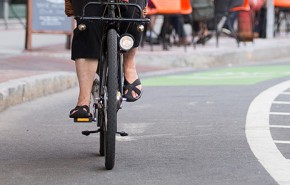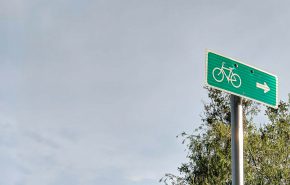In celebration of Bike Month, Week, and Day, which take place in May of each year, GAI is proud to be part of community- and citizen-inspired bike path planning, design, reconfiguration, and safety projects. From traffic studies to road diets, GAI professionals have delivered valuable services that allow cyclists to easily and safely pedal to work, home, and throughout their communities.
Bike Month: Six Decades of Celebrating Cycling
In 1956, the League of American Bicyclists established May as National Bike Month to highlight the benefits of cycling and the ways in which it can engage diverse communities. Today, National Bike Month continues to grow in popularity as cyclists across the U.S unite in support of their two-wheeled independence.
The Ability to Cycle
Cycling as a mode of transportation makes sense: it provides beneficial exercise, is a more wallet-friendly means of travel, and it reduces one’s carbon footprint. With a larger focus on creating livable communities with multi-modal transportation, many cities are now working to implement the necessary infrastructure for cyclists to ride safely.
Creating Bike-Friendly Communities
In the past, commutes in many U.S. cities have been centered around automobile traffic, creating antagonistic environments for cyclists. However, with residents embracing shorter travel times and healthier lifestyles, cities are answering the demand for bike-friendly environments and are partnering with engineering consulting firms toward that goal. GAI has worked with many communities in the regions we serve to design and implement bike-friendly projects—safely accommodating cyclists of varying skill levels and physical ability.
“Improved inclusion for the full range of possible users is a key consideration in our bike path designs,” said Senior Vice President and Transportation Business Unit Director, Kevin Leadbetter, PE, MBA. “Bicycle paths and recreational trails are required to be Americans with Disabilities Act (ADA) compliant, and at GAI we continually approach projects with the goal of meeting and exceeding these critical standards.”
For this Bike Month, we present some of GAI’s efforts to design, create, and improve bikeways for cyclists—one perhaps located in a neighborhood near you:
![]() Winter Park, FL. GAI, through an intensive consultation process with community stakeholders, developed several streetscape concepts for a one-mile segment of Denning Drive, featuring a transformative road diet. Despite right-of-way challenges, driveway cuts, and budget, GAI provided the city with several options that reduced the road from four lanes to three (one in each direction with a center turn lane). The final design incorporates a multi-use bike and pedestrian trail, enhanced intersections and crosswalks, and the addition of street trees to provide more shade along the trail. The City of Winter Park self-implemented the project, based on GAI’s detailed schematic design drawings, and completed the work in 2020.
Winter Park, FL. GAI, through an intensive consultation process with community stakeholders, developed several streetscape concepts for a one-mile segment of Denning Drive, featuring a transformative road diet. Despite right-of-way challenges, driveway cuts, and budget, GAI provided the city with several options that reduced the road from four lanes to three (one in each direction with a center turn lane). The final design incorporates a multi-use bike and pedestrian trail, enhanced intersections and crosswalks, and the addition of street trees to provide more shade along the trail. The City of Winter Park self-implemented the project, based on GAI’s detailed schematic design drawings, and completed the work in 2020.
Jacksonville, FL. Working with Archer Western, GAI provided design and construction services for the $126 million expansion of the which carries I-95 over the St. Johns River. The bridge expansion included a bike/pedestrian lane that provides connections to downtown and adjacent neighborhoods; upon completion, it served as the highest multi-modal bridge structure in Florida.
Jacksonville, FL. Working with the City of Jacksonville, GAI led the design and provided civil engineering services for bicycle and pedestrian improvements along Riverplace Boulevard, located on the Southbank of downtown Jacksonville. The automobile lanes were reduced from five to three to allow for buffered bike lanes, larger sidewalks, and upgraded pedestrian crossings. This new infrastructure component improves safety conditions for cyclists as well as facilitates access to this developing corridor and to the Southbank Riverwalk along the St. Johns River.
Clearwater, FL. GAI worked with the City of Clearwater to redevelop the gateway entrance into downtown along Cleveland Street. Implemented in 2019 from GAI’s master plan for the Cleveland Street Streetscape project, two driving lanes between Missouri Avenue and Gulf to Bay Boulevard were removed to allow for buffered bike lanes and wider sidewalks.

Pittsburgh, PA. As part of the Highland Avenue and East Liberty Boulevard intersection reconfiguration/safety improvement project, GAI worked with the Urban Redevelopment Authority to study, design, and ultimately deliver the first use of two-stage left turn boxes within the City of Pittsburgh. Making a left turn is often one of the most challenging maneuvers for cyclists and implementing a two-stage turn eliminates the conflicts with opposing through traffic. The application worked so well at this intersection that BikePGH, a local advocacy group, posted an informational video on how to use the two-stage left turn box within a week of opening the intersection to traffic. The project started as Pittsburgh Public School’s Obama Academy of International Studies and the School District’s desire to provide safer transit and bicycle/pedestrian options for students and the community.
Wauwatosa, WI. GAI led the visioning for the complete redesign of park space, six gateway intersections, and more than 6,000 linear feet of streetscape in the historic Wauwatosa Village. GAI’s solutions represent many progressive ideas, such as roadway realignments and road diets, low-impact rain gardens, shared space street designs, parklets, integrated cycle trails, and reverse-angle parking on two primary shopping streets. The project was completed in 2019 and won the Wisconsin Chapter American Society of Landscape Architects 2020 Design Merit Award.
![]() Charleston, WV. GAI worked with the City of Charleston to plan the Kanawha Trestle Walk and Bikeway System, a two-lane bikeway along Kanawha Boulevard from Pennsylvania Avenue to the Patrick Street Bridge. The project entails narrowing the existing four drive lanes and removing the grass median to make way for the new bikeway. The lane width reduction will also encourage safer and slower driving speeds.
Charleston, WV. GAI worked with the City of Charleston to plan the Kanawha Trestle Walk and Bikeway System, a two-lane bikeway along Kanawha Boulevard from Pennsylvania Avenue to the Patrick Street Bridge. The project entails narrowing the existing four drive lanes and removing the grass median to make way for the new bikeway. The lane width reduction will also encourage safer and slower driving speeds.
Greenwood, IN. GAI helped provide professional engineering and design services to the City of Greenwood for Phase 3 of the $12.5 million road diet of Madison Avenue, a major north-south corridor leading into downtown, known locally as “Old Town.” A 1.5-mile segment of roadway was reduced from four lanes to two and incorporates a cycle track, pedestrian-friendly sidewalks, improved signage, landscaping including rain gardens and hybrid ditches, and other streetscape enhancements.
Fort Wayne, IN. Addressing the City of Fort Wayne’s desire to become more pedestrian and bicycle friendly, GAI designed and provided construction services for the widening of approximately 2 miles of Dupont Road from two to four lanes. To maintain the flow of traffic within this busy corridor while incorporating the characteristics of a “livable street,” GAI provided context-sensitive design solutions such as a multi-use trail, sidewalk, new traffic signals, decorative LED street lighting, raised medians, LID drainage improvements, and landscaping including street trees. The project also includes a pedestrian/cyclist underpass that facilitates safe access to the popular, adjacent Pufferbelly Trail. This project won the American Council of Engineering Companies (ACEC) of Indiana 2020 Merit Award.
With these bike lane projects, GAI continues to help make communities safer and more accommodating for cyclists. Look for more bike lane developments in neighborhoods near and around you soon. In the meantime, get out your bike and helmet, and take advantage of the bike-friendly features in your community. Have fun cycling, and be safe!
If you snap and share a photo on social media, be sure to tag GAI on Twitter (GAIConsultants), Facebook (gaiconsultants), Instagram (gaiconsultants), and LinkedIn (gai-consultants-inc.).


